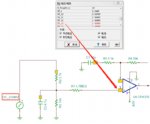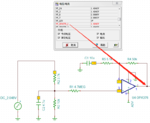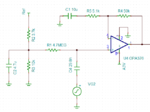Johnny_YU
Member level 2
Hi,All
In my Schematic , 1.5V should be detected on the positive input of OPA, and the output voltage should be 1.5V.
I use TINA to simulate the circuit , it shows the positive input of OPA is 1.494V,and the output voltage is 1.4948V.
But, When I test this circuit , I found that the positive input of OPA is about 220mV , the output voltage is 1.5V.
Why the positive input of OPA is 220mV? And Why the output voltage is still 1.5V?
In my Schematic , 1.5V should be detected on the positive input of OPA, and the output voltage should be 1.5V.
I use TINA to simulate the circuit , it shows the positive input of OPA is 1.494V,and the output voltage is 1.4948V.
But, When I test this circuit , I found that the positive input of OPA is about 220mV , the output voltage is 1.5V.
Why the positive input of OPA is 220mV? And Why the output voltage is still 1.5V?


